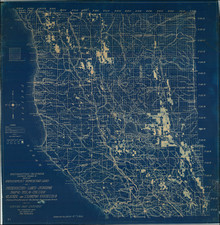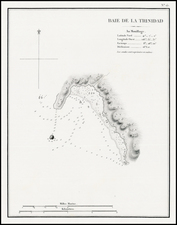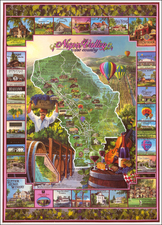California Indians!
Rare map of California, published by renowned map historian Augustus Petermann in 1879. The map is both a fine compendium of Indian information and an excellent overall treatment of both California and Nevada in general.
The map is based upon the work of American Stephen Power, whose book "Tribes of California", first published in Washington, DC is one of the most important works on the subject. In 1877, Stephen Power's seminal work, "Tribes of California," brought to light the rich tapestry of native cultures flourishing in California long before the establishment of European settlements. This essay explores some of the prominent tribes detailed in Power's book, shedding light on their distinct identities, ways of life, and traditions. The map is largely colored to show the major tribes of California, including:
-
Tinneh: Originally from the north, the Tinneh tribes migrated to various parts of the United States. Their presence in California is noted but they are more prominently recognized for their dominion in Alaska and western Canada.
-
Shas-Ta: Inhabiting the mountainous regions of northern California and southern Oregon, the Shas-Ta had a culture deeply connected to the natural world. Their lands provided abundant resources, enabling them to develop complex societies.
-
Mo'dok: Residing in what is now known as the Modoc Plateau, the Mo'dok were known for their resistance against U.S. forces, notably during the Modoc War. They had a rich tradition of hunting and fishing.
-
Yu-Rok: Settled along the Klamath River, the Yu-Rok were renowned for their fishing skills, especially salmon fishing. Their complex social structures and ceremonies showcased a profound spiritual connection to the river.
-
Ka-Rok: Neighbors to the Yu-Rok, the Ka-Rok also lived along the Klamath River and shared many cultural similarities, particularly the emphasis on river-based livelihoods.
-
Chim A-Ri-Ko: Occupying the lands along the Pit River, they were often in conflict with neighboring tribes. Their existence was marked by fierce independence and a unique linguistic heritage.
-
A-Cho-Ma-Wi: Living in the vicinity of the Pit River, their culture, and traditions were closely tied to the land and its resources, particularly acorns – a staple in their diet.
-
Sho-Sho'-Ni: The Sho-Sho'-Ni or Shoshone predominantly lived more inland but had some presence in California. They are primarily recognized for their vast territories stretching across the Great Basin.
-
Win-Tun: Spread across the Sacramento Valley, the Win-Tun tribes were numerous and had a rich tradition of basketry, music, and dance.
-
Yu'-Ki: Occupying the areas around the Eel River, they were known for their rituals, ceremonies, and a way of life deeply influenced by the river's cycle.
-
Po'-Mo: Spread across various regions in California, the Pomo were particularly notable for their intricate basketry, a testament to their skilled craftsmanship.
-
Washo: Inhabiting regions around Lake Tahoe, the Washo had a culture deeply entwined with the lake's resources, with fishing and hunting playing prominent roles.
-
Mai'-Du: Settled in the Sierra Nevada foothills, the Maidu were distinguished by their diverse range of arts, including intricate tattoos and beadwork.
-
Mut-Sun: A division of the Ohlone people, they inhabited the Central Coast, particularly around the Monterey area.
-
Yo-Kuts: Residing in the San Joaquin Valley, they sustained themselves through hunting, gathering, and fishing, with acorns being a dietary staple.
-
Yuma: Positioned along the Colorado River, the Yuma (or Quechan) people were river-centric in their ways of life, practices, and beliefs.
-
San-Antonio: This tribe, named after the mission near their territory, lived in the southern part of California and had its own set of customs, albeit influenced by neighboring tribes.
-
Santa Barbara: Like the San-Antonio, they were named after the nearby mission and lived on the coastal regions of southern California, interacting with various coastal resources.
August Heinrich Petermann (1822-1878) is a renowned German cartographer of the nineteenth century. Petermann studied cartography at the Geographical Art-School in Potsdam before traveling to Edinburgh to work with Dr. A. Keith Johnston on an English edition of Berghaus’ Physical Atlas. Two years later he moved to London, where he made maps and advised exploratory expeditions as they set off to explore the interior of Africa and the Arctic.
In 1854, Petermann returned to Germany to be Director of the Geographical Institute of Justus Perthes in Gotha. There, he was the editor of the Geographische Mittheilungen and Stieler’s Handatlas. The Royal Geographical Society of London awarded him their Gold Medal in 1860. He continued his interest in exploration in Germany, fundraising for the German Exploring Expeditions of 1868 and 1869-70, which sought an open Arctic sea. Tragically, he committed suicide in 1878.











![[ The Ptolemaic Universe ] Situs Terrae Circulis Coelestibus Circundatae . . .](https://storage.googleapis.com/raremaps/img/small/101512.jpg)


![[California, Texas, and Southwest Globe Gore] with [Strait of Anian Globe Gore]](https://storage.googleapis.com/raremaps/img/small/99425.jpg)